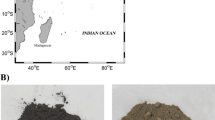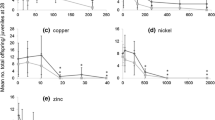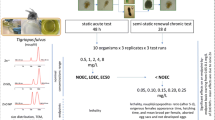Abstract
Triphenyltin compounds (TPTs), as effective biocides for different industrial and agricultural purposes, have been detected in coastal marine environments worldwide, in particular in Asian countries. However, little is known about their toxicity to marine organisms. This study comprehensively investigated the molecular, individual and population responses of the marine copepod, Tigriopus japonicus upon waterborne exposure to TPT chloride (TPTCl). Our results indicated that TPTCl was highly toxic to adult T. japonicus, with a 96-h LC50 concentration at 6.3 μg/L. As shown in a chronic full life-cycle test, T. japonicus exposed to 1.0 μg/L TPTCl exhibited a delay in development and a significant reduction of population growth, in terms of the intrinsic rate of increase (r m ). Based on the negative relationship between the r m and exposure concentration, a critical effect concentration was estimated at 1.6 μg/L TPTCl; at or above which population extinction could occur. At 0.1 μg/L TPTCl or above, the sex ratio of the second generation of the copepod was significantly altered and changed to a male-biased population. At molecular level, the inhibition of the transcriptional expression of glutathione S-transferase related genes might lead to dysfunction of detoxification, and the inhibition of retinoid X receptor mRNA expression implied an interruption of the growth and moulting process in T. japonicus. As the only gene that observed up-regulated in this study, the expression of heat shock protein 70 (hsp70) increased in a concentration-dependent manner, indicating its function in protecting the copepod from TPT-mediated oxidative stress. The study advances our understanding on the ecotoxicity of TPT, and provides some initial data on its toxic mechanisms in small crustaceans like copepods.






Similar content being viewed by others
References
Al-Ghais SM, Ali B (1999) Inhibition of glutathione S-transferase catalyzed xenobiotic detoxication by organotin compounds in tropical marine fish tissues. Bull Environ Contam Toxicol 62:207–213
Bao VWW (2009) Toxicities and ecological risks of selected antifouling biocides to marine organisms in Hong Kong. Ph.D. Thesis. The University of Hong Kong, Hong Kong, China
Bao VWW, Leung KMY, Lui GCS, Lam MHW (2013) Acute and chronic toxicities of Irgaol alone and in combination with copper to the marine copepod Tigriopus japonicus. Chemosphere 90:1140–1148
Bradford MM (1976) A rapid and sensitive method for the quantification of microgram quantities of protein utilizing the principle of protein–dye binding. Anal Biochem 72:79–86
Choi YK, Jo PG, Choi CY (2008) Cadmium affects the expression of heat shock protein 90 and metallothionein mRNA in the Pacific oyster, Crassostrea gigas. Comp Biochem Physiol C Toxicol Pharmacol 147:286–292
De Pomerai DI (1996) Review: heat-shock proteins as biomarkers of pollution. Hum Exp Toxicol 15:279–285
Durica DS, Hopkins P (1996) Expression of the genes encoding the ecdysteroid and retinoid receptors in regenerating tissues of the fiddler crab, Uca pugilator. Gene 171:237–241
Finney CM (1979) Salinity stress in harpacticoid copepods. Estuaries 2:132–135
Garrido C, Schmitt E, Candé C, Vahsen N, Parcellier A, Kroemer G (2003) Spotlight on heat shock proteins hsp27 and hsp70: potentially oncogenic apoptosis inhibitors. Cell Cycle 2:579–584
Goodman LR, Cripe GM, Moody PH, Halsell DG (1988) Acute toxicity of malathion, trtrabromobisphenol-A, and tributyltin chloride to mysids (Mysidopsis bahia) of three ages. Bull Environ Contam Toxicol 41:746–753
Hayes KR, Bradfield CA (2005) Advances in toxicogenomics. Chem Res Toxicol 18:403–414
Hensen JA, Lipton J, Welsh PG, Morris J, Cacela D, Suedkamp MJ (2002) Relationship between exposure duration, tissue residues, growth, and mortality in rainbow trout (Oncorhynchus mykiss) juveniles sub-chronically exposed to copper. Aquat Toxicol 58:175–188
Hill KAJ (2009) Changes in gene expression, lipid class and fatty acid composition associated with diapauses in the marine copepod Calanus finmarchicus from Loch Etive, Scotland. Ph.D. Thesis. The University of St. Andrews, Scotland
Horiguchi T, Shiraishi H, Shimizu M, Yamazaki S, Morita M (1995) Imposex in Japanese gastropods (neogastropoda and mesogastropoda): effects of tributyltin and triphenyltin from antifouling paints. Mar Pollut Bull 31:402–405
Horiguchi T, Shiraishi H, Shimizu M, Morita M (1996) Effects of triphenyltin chloride and five other organotin compounds on the development of imposex in the rock shell, Thais clavigera. Environ Pollut 95:85–91
Horiguchi T, Imai T, Cho HS, Shiraishi H, Shibata Y, Morita M, Shimizu M (1998) Acute toxicity of organotin compounds to the larvae of the rock shell, Thais clavigera, the disk abalone, Haliotis discus discus and the giant abalone, Haliotis medaka. Mar Environ Res 46:469–473
Horiguchi T, Nishikawa T, Ohta Y, Shiraishi H, Morita M (2007) Retinoid X receptor gene expression and protein content in tissues of the rock shell Thais clavigera. Aquat Toxicol 84:379–388
Hu J, Zhen H, Wan Y, Gao J, An W, An L, Jin F, Jin X (2006) Trophic magnification of triphenyltin in a marine food web of Bohai Bay, north China: comparison to tributyltin. Environ Sci Technol 40:3142–3147
Huang G, Song Z, Liu G, Zhang W (2002) Toxic effect of triphenyltin chloride on the alga Spirulina subsalsa. Appl Organomet Chem 16:117–122
Huang Y, Zhu L, Liu G (2006) The effects of bis(tributyltin) oxide on the development, reproduction and sex ratio of calanoid copopod Pseudodiaptomus marinus. Estuar Coast Shelf Sci 69:147–152
Hunziker RW, Escher BI, Schwarzenbach RP (2002) Acute toxicity of triorganotin compounds: different specific effects on the energy metabolism and role of pH. Environ Toxicol Chem 21:1191–1197
Hwang D-S, Lee J-S, Lee K-W, Rhee J-S, Han J, Lee J, Park GS, Lee Y-M, Lee J-S (2010) Cloning and expression of ecdysone receptor (EcR) from the intertidal copepod, Tigriopus japonicus. Comp Biochem Physiol Part C: Toxicol Pharmacol 151:303–312
Jager T, Crommentuijn T, VanGestel CAM, Kooijman SALM (2002) Simultaneous modeling of multiple end points in life-cycle toxicity tests. Environ Sci Technol 38:2894–2900
Ki J-S, Raisuddin S, Lee K-W, Hwang D-S, Han J, Rhee J-S, Kim I-C, Park HG, Ryu J-C, Lee J-S (2009) Gene expression profiling of copper-induced responses in the intertidal copepod Tigriopus japonicus using a 6K oligochip microarray. Aquat Toxicol 93:177–187
Kim R-O, Rhee J-S, Lee K-W, Kang C-M, Lee Y-M, Lee J-S (2011) Ultraviolet B retards growth, induces oxidative stress, and modulates DNA repair-related gene and heat shock protein gene expression in the monogonont rotifer, Brachionus sp. Aquat Toxicol 101:529–539
Kim B-M, Choi B-S, Lee K-W, Ki J-S, Kim I-C, Choi I-Y, Rhee J-S, Lee J-S (2013) Expression profile analysis of antioxidative stress and developmental pathway genes in the manganese-exposed intertidal copepod Tigriopus japonicus with 6K oligochip. Chemosphere 92:1214–1223
Kregel KC (2002) Heat shock proteins: modifying factors in physiological stress responses and acquired thermotolerance. J Appl Physiol 92:2177–2186
Kwok KWH, Leung KMY (2005) Toxicity of antifouling biocides to the intertidal harpacticoid copepod Tigriopus japonicus (Crustacea, Copepoda): effects of temperature and salinity. Mar Pollut Bull 51:830–837
Kwok KWH, Leung KMY, Bao VWW, Lee JS (2008) Copper toxicity in the marine copepod Tigropus japonicus: low variability and high reproducibility of repeated acute and life-cycle tests. Mar Pollut Bull 57:632–636
Kwok KWH, Grist EPM, Leung KMY (2009) Acclimation effect and fitness cost of copper resistance in the marine copepod Tigriopus japonicus. Ecotoxicol Environ Saf 72:358–364
Kwok KWH, Leung KMY, Flahaut E, Cheng JP, Cheng SH (2010) Chronic toxicity of double-walled carbon nanotubes to three marine organisms: influence of dispersion methods. Nanomedicine 5:951–961
Lauritano C, Procaccini G, Ianora A (2012) Gene expression patterns and stress response in marine copepods. Mar Environ Res 76:22–31
LeBlanc GA (2007) Crustacean endocrine toxicology: a review. Ecotoxicology 16:61–81
Lee Y-M, Park T-J, Jung S-O, Seo J-S, Park HG, Hagiwara A, Yoon Y-D, Lee J-S (2005) Cloning and characterization of glutathione S-transferase gene in the intertidal copepod Tigriopus japonicus and its expression after exposure to endocrine-disrupting chemicals. Mar Pollut Bull 62:S219–S223
Lee SM, Lee SB, Park CH, Choi J (2006) Expression of heat shock protein and hemoglobin genes in Chironomus tentans (Diptera, Chironomidae) larvae exposed to various environmental pollutants: a potential biomarker of freshwater monitoring. Chemosphere 65:1074–1081
Lee K-W, Raisuddin S, Hwuang D-S, Park H-G, Lee J-S (2007a) Acute toxicities of trace metals and common xenobiotics to the marine copepod Tigriopus japonicus: evaluation of its use as a benchmark species for routine ecotoxicity tests in western pacific coastal regions. Environ Toxicol 22:532–538
Lee Y-M, Lee K-W, Seo JS, Park H, Park H-G, Ahn I-Y, Raisuddin S, Lee J-S (2007b) Sequence, biochemical characteristics and expression of a novel sigma class of glutathione S-transferase of intertidal copepod, Tigriopus japonicus with a possible role in antioxidant defense. Chemosphere 69:893–902
Lee K-W, Raisuddin S, Huang D-S, Park H-G, Dahm H-U, Ahn I-Y, Lee J-S (2008a) Two-generation toxicity study on the copepod model species Tigriopus japonicus. Chemosphere 72:1359–1365
Lee K-W, Raisuddin S, Rhee J-S, Hwuang D-S, Yu IT, Lee Y-M, Park HG, Lee J-S (2008b) Expression of glutathione S-transferase (GST) genes in the marine copepod Tigriopus japonicus exposed to trace metals. Aquat Toxicol 89:158–166
Leung KMY, Grist EPM, Morley NJ, Morritt D, Crane M (2007) Chronic toxicity of tributyltin to development and reproduction of the European freshwater snail Lymnaea stagnalis (L.). Chemosphere 66:1358–1366
Livak KJ, Schmittgen TD (2001) Analysis of relative gene expression data using real time quantitative RPC and the 2−ΔΔCT method. Methods 25:402–408
Marcial HS, Hagiwara AH, Snell TW (2003) Estrogenic compounds affect development of harpacticoid copepod Tigriopus japonicus. Environ Toxicol 22:3025–3030
McCahon CP, Pascoe D (1988) Use of Gammarus pulex (L.) in safety evaluation tests: culture and selection of a sensitive life stage. Ecotoxicol Environ Saf 15:245–252
McCarthy DJ, Smyth GK (2009) Testing significance relative to a fold-change threshold is a TREAT. Bioinformatics 25:765–771
Meador JP (1993) The effect of laboratory holding on the toxicity response of marine infaunal amphipods to cadmium and tributyltin. J Exp Mar Biol Ecol 174:227–242
Nishikawa J, Mamiya S, Nishikawa T, Shiraishi F, Horiguchi T (2004) Involvement of the retinoid X receptor in the development of imposex caused by organotins in gastropods. Environ Sci Technol 38:6271–6276
Novelli AA, Arese E, Tagliapietra D, Bettiol C, Ghirardini AV (2002) Toxicity of tributyltin and triphenyltin to early life-stages of Paracentrotus lividus (Echinodermata: Echinoidea). Environ Toxicol Chem 21:859–864
Ohji M, Arai T, Miyazaki N (2002) Effects of tributyltin exposure in the embryonic stage on sex ratio and survival rate in the caprellid amphipod Caprella danilevskii. Mar Ecol Prog Ser 235:171–176
Peart MJ, Smyth GK, Van Laar RK, Bowtell DD, Richon VM, Marks PA, Holloway AJ, Johnstone RW (2005) Identification and functional significance of genes regulated by structurally different histone deacetylase inhibitors. Proc Natl Acad Sci USA 102:3697–3702
Preston BL, Snell TW (2001) Full life-cycle toxicity assessment using rotifer resting egg production: implications for ecological risk assessment. Environ Pollut 114:399–406
Raisuddin S, Kwok KWH, Leung KMY, Schlenk D, Lee J-S (2007) The copepod Tigriopus: a promising marine model organism for ecotoxicology and environmental genomics. Aquat Toxicol 83:161–173
Rantakokko P, Hallikainen A, Airaksinen R, Vuorinen PJ, Lappalainen A, Mannio J, Vartiainen T (2010) Concentrations of organotin compounds in various fish species in the Finnish lake waters and Finnish coast of the Baltic Sea. Sci Total Environ 408:2474–2481
Raouf A, Zhao Y, To K, Stingl J, Delaney A, Barbara M, Iscove N, Jones S, McKinney S, Emerman J, Aparicio S, Marra M, Eaves C (2008) Transcriptome analysis of the normal human mammary cell commitment and differentiation process. Cell Stem Cell 3:109–118
Rhee J-S, Raisuddin S, Lee K-W, Seo JS, Ki J-S, Kim I-C, Park HG, Lee J-S (2009) Heat shock protein (Hsp) gene responses of the intertidal copepod Tigriopus japonicus to environmental toxicants. Comp Biochem Physiol Part C: Toxicol Pharmacol 149:104–112
Salinas A, Wong MG (1999) Glutathione S-transferases: a review. Curr Med Chem 6:279–309
Schimicki T, Karsai I (2010) The interplay of sex ratio, male success and density-independent mortality affects population dynamics. Ecol Model 221:1089–1097
Schmidt K, Steinberg CEW, Pflugmacher S, Staaks GBO (2004) Xenobiotic substances such as PCB mixtures (Aroclor 1254) and TBT can influence swimming behavior and biotransformation activity (GST) of carp (Cyprinus carpio). Environ Toxicol 19:460–470
Seo JS, Lee K-W, Rhee J-S, Hwang D-S, Lee Y-M, Park HG, Ahn I-Y, Lee J-S (2006) Environmental stressors (salinity, heavy metals H2O2) modulate expression of glutathione reductase (GR) gene from the intertidal copepod Tigriopus japonicus. Aquat Toxicol 80:281–289
Shimuzu A, Kimura S (1991) Acute toxicity of triphenyltin chloride (TPTC) to the saltwater goby, Chasmichthys dolichognathus in natural seawater and artificial seawater. Bull Natl Res Inst Fish Sci 2:33–39
Shu Y, Du Y, Wang J (2011) Molecular characterization and expression patterns of Spodoptera litura heat shock protein 70/90, and their response to zinc stress. Comp Biochem Physiol Part C: Toxicol Pharmacol 158:102–110
Singh SP, Coronella JA, Benes H, Cochrane BJ, Zimniak P (2001) Catalytic function of Drosophila melanogaster glutathione S-transferase DmGSTS1-1 (GST-2) in conjugation of lipid peroxidation end products. Cell Mol Biol 268:2912–2923
Smith LB (1965) The intrinsic rate of natural increase of Cryptolestes ferrugineus (Stephens) (Coleoptera, Cucujidae). J Stored Prod Res 1:35–49
Takeda N (1950) Experimental studies on the effect of external agencies on the sexuality of a marine copepod. Physiol Zool 23:188–301
Tartarotti B, Torres JJ (2009) Sublethal stress: impact of solar UV radiation on protein synthesis in the copepod Acartia tonsa. J Exp Mar Biol Ecol 375:106–113
Tiano L, Davies I, Craft J, Falcioni G (2004) Analysis of stress-induced gene expression in trout red blood cells following tributyltinchloride exposure. Fish Physiol Biochem 30:231–240
[USEPA] U.S. Environmental Protection Agency, Office of Pesticide Programs (2000) Annual Report 2000. Washington DC: USEPA. EPA/735/R-00/002
Voordouw MJ, Anholt BR (2002) Environmental sex determination in a splash pool copepod. Biol J Linn Soc 76:511–520
Walthall WK, Stark JD (1997) A comparison of acute mortality and population growth rate as endpoints of toxicological effect. Ecotoxicol Environ Saf 37:45–52
Wang M, Wang G (2010) Oxidative damage effects in the copepod Tigriopus japonicus Mori experimentally exposed to nickel. Ecotoxicology 19:273–284
Wang YH, Wang G, LeBlanc GA (2007) Cloning and characterization of the retinoid X receptor from a primitive crustacean Daphnia magna. Gen Comp Endocrinol 150:309–318
Wang X, Hong H, Zhao D, Hong L (2008) Environmental behaviour of organotin compounds in the coastal environment of Xiamen, China. Mar Pollut Bull 57:419–424
Wong SWY, Leung KMY (2013) Temperature-dependent toxicities of nano zinc oxide to marine diatom, amphipod and fish in relation to its aggregation size and ion dissolution. Nanotoxicology. doi:10.3109/17435390.2013.848949
Worboys MA, Leung KMY, Grist EPM, Crane M (2002) Time should be considered in developmental ecotoxicity tests. Mar Pollut Bull 45:92–99
Yi AX, Leung KMY, Lam MHW, Lee JS, Giesy JP (2012) Review of measured concentrations of triphenyltin compounds in marine ecosystems and meta-analysis of their risks to humans and the environment. Chemosphere 89:1015–1025
Acknowledgments
This work is substantially supported by the Area of Excellence Scheme under the University Grants Committee (Project No. AoE/P-04/2004) of the Hong Kong SAR Government. Andy Yi thanks the Swire Institute of Marine Science and the University of Hong Kong to provide him a PhD studentship. This work was partially supported by a Grant of MOMAF (2012) funded to Jae-Seong Lee.
Conflict of interest
The authors declare that they have no conflict of interest.
Author information
Authors and Affiliations
Corresponding author
Rights and permissions
About this article
Cite this article
Yi, A.X., Han, J., Lee, JS. et al. Ecotoxicity of triphenyltin on the marine copepod Tigriopus japonicus at various biological organisations: from molecular to population-level effects. Ecotoxicology 23, 1314–1325 (2014). https://doi.org/10.1007/s10646-014-1274-y
Accepted:
Published:
Issue Date:
DOI: https://doi.org/10.1007/s10646-014-1274-y




